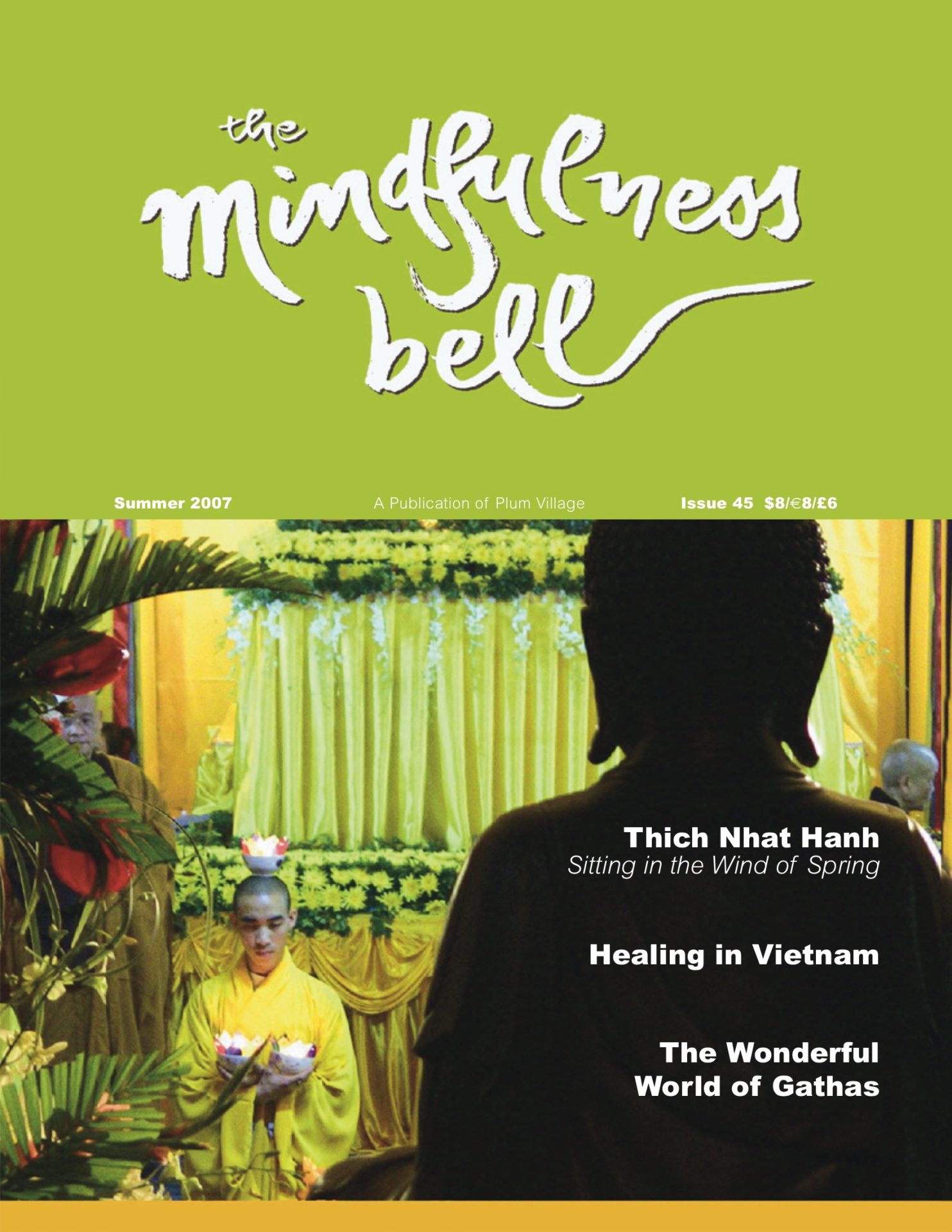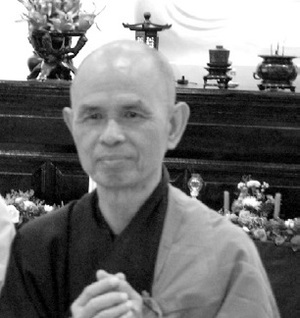
In early 2007 Thich Nhat Hanh led a ninety-day pilgrimage to Vietnam. Fifty monks and nuns from the monasteries in the U.S. and France accompanied him, along with a hundred lay Westerners, in each of four three-week segments. On this second historic visit to his homeland, Thay was also accompanied by Vietnamese monks and nuns numbering in the hundreds, from the three monasteries in Vietnam that practice in the tradition of Plum Village.

In early 2007 Thich Nhat Hanh led a ninety-day pilgrimage to Vietnam. Fifty monks and nuns from the monasteries in the U.S. and France accompanied him, along with a hundred lay Westerners, in each of four three-week segments. On this second historic visit to his homeland, Thay was also accompanied by Vietnamese monks and nuns numbering in the hundreds, from the three monasteries in Vietnam that practice in the tradition of Plum Village.
As of this writing, Thay has offered two Great Ceremonies of Healing, also called Grand Requiem Masses, for the souls of those who perished during the Vietnam War. Never before has Vietnam seen such ceremonies. In the first ceremony in Ho Chi Minh City, as many as ten thousand people participated.
Here are writings and photos from two lay participants. David Nelson, Compassionate Guidance of the Heart, recently retired after eighteen years working in public health on Indian reservations in the southwestern U.S. He now practices with the Organic Garden and Ripening Sanghas in southern California. Madeline Dangerfield-Cha from Cleveland, Ohio, will enter Columbia University next fall; she has four half-brothers and one half-sister under the age of seven. Look for more about this historic trip in the next issue of the Mindfulness Bell, and view additional photos by David Nelson at www.flickr.com/photos/rezdog/. Hear Dharma talks and interviews from the Vietnam trip at www.dpcast.org.
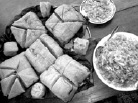
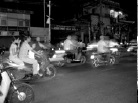
Arrival Day in Ho Chi Minh City
At the Quang Duc Temple, there was a great welcoming ceremony for Thay and the sangha. After a long formal procession, Touching the Earth was offered to the temple’s venerables for a long life to the patriarch that may continue to benefit many. The most venerable offered warm greetings and wishes for a successful trip. Next we took buses to An Quang temple. Thay shared that at this temple he became a Dharma teacher, giving hundreds of Dharma talks in that hall. Afterwards our procession slowly passed by smiling and bowing crowds and made its way to a most delicious Vietnamese feast. We dined to the sounds of up-beat popular music. That night at Phap Van, Thay gave his first talk of the trip. We in the lay sangha were fortunate to witness the talk from directly behind Thay, and to see the faces in the audience. Thay encouraged us to practice coming back to our breath as taught by the Buddha in the Anapanasati Sutra on mindful breathing. [Read part of this Dharma talk on page 4.]
—David Nelson
All photos in this section by David Nelson and Madeline Dangerfield-Cha
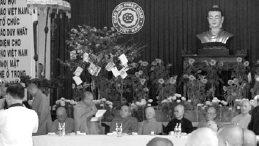
Thousands on a Few Green Acres
The five-day lay retreat at Prajna Temple near Bao Loc was a wonderful gift. I hardly expected such intense practice! And so many people! Upwards of seven thousand Vietnamese retreatants came. You’d think it would be chaos, thousands of people on a few green acres. How on earth could seven thousand people remain meditative and quiet for five days in 90-degree heat? But these people are truly devoted: three thousand could cram into the meditation hall for Thay’s Dharma talks, the rest sprawling on the steps and lawn outside. Thay was so inspiring, so down to earth.
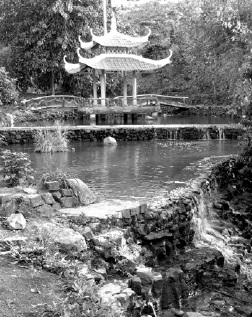
For Dharma discussion, I was lucky enough to be included in a bilingual, multi-cultural, youth exchange extravaganza! A large group of monks, nuns, Vietnamese, and young Westerners, we discussed our experiences and challenges. The Vietnamese young people were slow to share, really hesitant, since “sharing,” they explained, is not a part of their culture. Yet after just a few minutes on the first day they began to share their suffering so we could join their journey. We played high energy games and goofy challenges. Everyone could shout and laugh, Vietnamese or English!
—Madeline Dangerfield-Cha
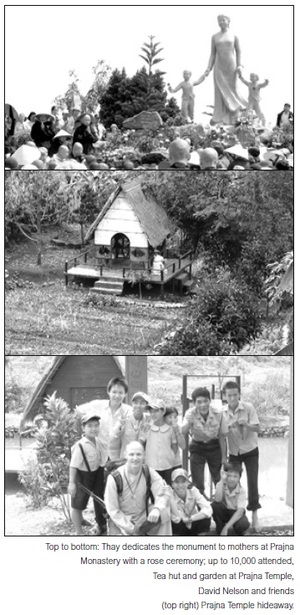
Jungle School Adventure
Ha! I can’t even begin to describe the joy from yesterday’s adventure! The plan for the day was to visit schools in the central highlands around Bao Loc. Plum Village funds the construction, staff, and supplies of over a thousand schools in the whole of Vietnam, a million-dollar charity organization. Yesterday, we visited nine of them, real schools with real kids and real teachers. Just single room, no-frills buildings. Some have desks, some have chalkboards. No books, no toys. But they’re clean, and they’re built! The kids get one well-rounded, nutritious meal per day. Our first stop was a tribal village where most of the inhabitants spoke the local dialect. I played tag with more than forty six- and seven-year-olds. I felt like I was playing with my little brothers. You should have seen their smiles!
But the real adventure began in the jungle. No more plumbing, no more pavement, no more cars of any kind. A nun turned to me and said, “You know, this road gets completely unpassable when it rains. Turns into nothing but mud. The tires can’t move at all. Hey, look it’s raining in the distance!” It did rain cats and dogs — torrential, tropical, southeast-Asian rain, for thirty-five minutes. We were completely frozen, stuck in a muddy river the whole time, twelve of us tucked in our little monastic van. We passed around boiled peanuts and rice cakes and purified water. It was a beautiful storm, like a fever breaking, as the heat and humidity dropped.
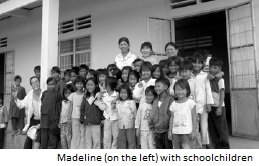
As soon as the rain slowed, Sister Chan Khong (the one and only! this woman has lived!) said “Alright, let’s go. The kids are waiting for us!” Our poor driver got us as far as he could, which was about a kilometer down the road. We left the other two vans behind. Sister said, “Can’t drive any further. We walk!” and jumped out of the van. The sky had cleared by this time, and all the dusty vegetation had been rinsed clean and was glowing with color. Muddy red earth, big gray sky.
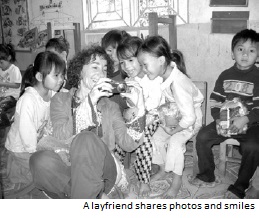
The walk was long and sticky. I almost lost a shoe at one point, so ended up barefoot in red mud — cool and fresh. Local kids in blue and red uniforms whizzed by us on motorbikes. A man on a motorbike stopped by, asking us if we needed a hand. Sister Chan Khong was all about it! This seventy-year old Vietnamese rock star just tucked up her robes and was off.
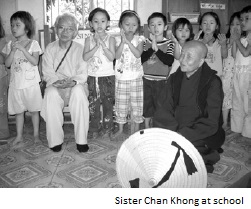
The rest of us walked up and down muddy hills through the brush. Coffee plants taller than men. Little kids joining us, then peeling off on tiny paths, presumably to their homes hidden among the plantlife and mist.
At the school, since we couldn’t bring the gifts, a few people offered crackers. Someone had a brick of cheese. We dumped what we had into a cone hat and passed it around to the children, who ate with joy. In one of the poorest areas that Plum Village supports, these people are happy, functioning. They don’t need plumbing or cars in order to live.
—Madeline Dangerfield-Cha
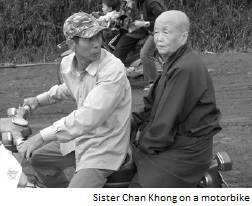
Powerful and Jubilant Alms Round
In Bao Loc today, the alms round led by Thay in a black Highlander — the Buddha-mobile — was powerful, jubilant! Two thousand monks and nuns passed through streets mobbed by old women, children, and families offering toothpaste, medicine, sweet treats, yogurt, fruit, and the traditional boiled rice wrapped in a banana leaf with sesame salt. The Western lay delegation stood on the sidelines with Vietnamese locals; we helped collect the unbelievable excess of food, stuffing it into army sacks for later donations.
Playing with small children, we had our pictures taken by the locals, who love taking photos of us. My friends Brant and Ray are both six feet four inches — giants here in Asia. People run up to them and measure themselves, waving their hands over their heads and matching them up with the middle of Brant’s forearm. It’s hilarious.
—Madeline Dangerfield-Cha

The First Great Requiem Ceremony
Thich Nhat Hanh declares during his Dharma talk at Vinh Nghiem Temple on this second day of ceremony that we will continue to open the throats of hungry ghosts. Along with powerful chants led by a chant master specializing in inviting spirits, the souls of those who died during the war, whether as heroes, in prison, of sickness, on land or sea, will be purified by the compassion and energy of the Dharma.
Day two begins with chants from the discourse on love, to detach the souls from the bodies. Everyone is requested to bring themselves wholeheartedly into the chants and not disturb the energy by moving around and taking pictures. First there is the Beginning Anew gatha of forgiveness, lightness and freedom. From the depths of understanding, with great emotion and steadfastness, the chants roar and pulsate throughout this huge temple. In the afternoon there is chanting to invoke the presence of the Medicine King, a previous incarnation of the Buddha. Led by the chant master, local traditional chants flow like a mighty river of heart-felt sound, non-stop for nearly two hours, echoing inside and outside among thousands in the courtyard. So many thousands of voices giving energy to the healing! Thay declares that as Beginning Anew transforms our hearts and those of the loved ones departed, the nightmare of the Vietnam War is over. The squash and the pumpkin co-exist peacefully on the same vine.
In the evening we in the lay sangha are amazed to become part of the lotus lamp ceremony. The procession line forms, with colorful umbrellas, flags, and other ceremonial poles. I stand near the beginning with my palms together to show respect to the monastics as they file by. As Thay arrives, looking over at me, he smiles. Raising his hand, he waves, wiggling his fingers in a cute gesture. I return the wave and smile. As our lay sangha follows, filing through a narrow opening, we pass shrines and a wishing well altar. The people offer us lotus bows and big smiles.
This evening is lit with spotlights, colored lanterns, the booming sounds of a big drum, cymbals, and bells, accompanying chants from the monastics and crowd. After a half-hour of waiting, our line is ushered quickly past attendants who offer us hand-made paper lotuses containing candles. Circling the temple, we glow, a beautiful candle-lit lane awaiting the chant master. More monastics, an entourage of musicians and traditionally dressed young women pass, smiling. We follow them to the Saigon River behind the temple, passing by big, bowing crowds. We place our glowing lotuses into the river where they float like beacons to light the souls lost in darkness — that they may join us during this transformative healing and reconciliation ceremony.
The dead have been invited to the temple to begin anew with us. On day three Thay states that this is the largest such ceremony ever in Vietnam — an action of love to bring individuals, families, and the nation into harmony and peace. We join in untying knots of injustice for all beings. Thay offers prayers for those who lost their precious bodies, that through our consciousness, they might be healed. Thay helps the audience understand how to walk and breathe as he does, with the energy of lightness and freedom.
Sister Chan Khong sings a song of Beginning Anew, teaching it to the audience. With tears in their eyes, they sing along. Greed, anger, passion, and ignorance are offered a chance to transform. People comfort one another. A large indoor screen projects the crowd’s faces of regret, forgiveness, and hope. Thay tells us that even the Communist party has admitted their mistakes of taking land and killing so many, although they refer to it as a correction rather than Beginning Anew. Everyone learns that once the mind is purified there is no trace of past unskillfulness, no guilt, no sin. Sitting in the spring breeze, teacher and students are happy as a family.
—David Nelson
‘Thank God for Thich Nhat Hanh’
Hue is the closest city to the DMZ (demilitarized zone), which remains the most heavily bombed piece of earth on this planet. Slowly, I’m formulating a sense of the real devastation of this war and all wars. Agent Orange is still wreaking havoc. Even today, babies are born with terrible deformities due to exposure. Many older Agent Orange victims beg here on the streets of Hue and in the temples where we go to practice. The suffering, I see, is enormous, continuous.

The response that keeps re-surfacing is “Thank God for Thich Nhat Hanh” — a leader, a visionary. He’s fighting the bureaucracy with peace and love and compassion and understanding. Without resentment or cynicism or demand. He is fighting and he will win. It may take many more generations, but his message is true. Love all beings. Prevent all possible suffering. Act with compassion. Do not kill. Do not discriminate. The Communist officials here breathe down his neck. For thirty years, they repressed him and killed his supporters. Yet he is here, now, and he will not stop fighting with love and grace and dedication.
—Madeline Dangerfield-Cha
Coming Home to Hue
When we arrived at Tu Hieu, Thay was just finishing an impromptu tour of the grounds, explaining his activities as a young novice. Walking through the front gate, he motioned to the left-most of three stone arches and recounted the details of his first entrance when he was only 16 years old. His older brother was already a novice, and had brought Thay to study with him. His brother instructed Thay to walk through the arch in full awareness of every step and of every breath, invoking the name of the Buddha. Right, I am breathing in. Namo Shakyamuni Buddhaya. Left, I am breathing out. Namo Shakyamuni Buddhaya. Those, he said, were his first steps on the path of mindfulness. He invited each of us to do as he had done.
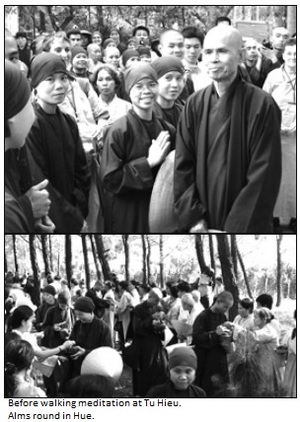
Sitting together on the shady grass, monastics and international lay friends, we are all smiling as a great family. Thay is cupping a flower in his left hand, which he brings up to his face every so often, breathing in with great joy. He motions to a young monk, maybe ten or eleven years old, to sit close to him, extending the flower to the boy, sharing its beautiful fragrance. The young novice is nervous and smiling, his legs curled beneath him, his back upright and erect. Thay puts an arm around his shoulders, and invites another young monastic to share a song. Many have been singing traditional folk songs or older Buddhist chants. This young monk sings a popular Vietnamese love song. His voice is warbling and full of laughter. His Vietnamese brothers and sisters laugh through the whole song. Our teacher is bright with joy and humor.
—Madeline Dangerfield-Cha

